Last Saturday, I explored the latest in the “instant downtowns” that now encircle Toronto, wedged in between Highways 7 and 407, Warden and Kennedy in Markham, specifically, a development called “Downtown Markham”.
Downtown Markham is the name of a development by Remington Homes, where the sole developer seeks to build an urban centre for this fast-growing suburb northeast of Toronto. However, it should be said that “Downtown Markham” is still a marketing name, the larger area surrounding it is called Markham Centre, and is also being intensified with townhouses and mid-rise and high-rise condo residences.
The largest and most well-known of these “instant downtowns” is Mississauga City Centre, where offices, condos and civic buildings followed the construction of the Square One shopping mall, itself built about the time that the towns of Port Credit and Streetsville were amalgamated with the once-rural but fast-growing Toronto Township/Town of Mississauga. As a city centre, Mississauga doesn’t quite work. Parking lots and six-to-eight lane arterials separate many older buildings not designed for an urban context, and all the shopping is indoors in the mall. New condos and townhouses to the west of the admittedly monumental city hall follow a more urban street grid, but there’s still little on the ground. The lack of rapid transit also hurts it.
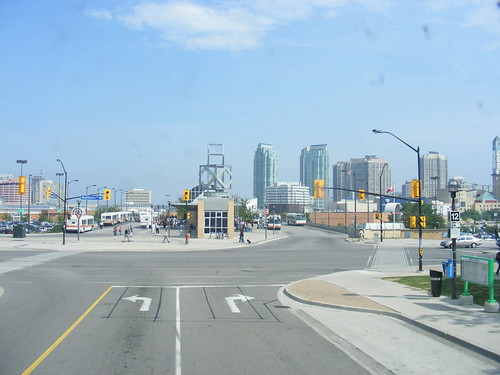 Mississauga City Centre, as seen from the top of a GO double-deck bus.
Mississauga City Centre, as seen from the top of a GO double-deck bus.
Meanwhile other suburbs, such as Brampton, have seen some luck with intensifying their existent, yet struggling, downtown cores. North York took a middle approach, intensifying Yonge Street with offices and condos and new civic and arts centres, with mixed success (the remaining 1950s/1960s retail strips add life to the typical sterility of condo-base retail. (On streets like Bay, the retail landscape feels like Rabba, bank, Subway, cleaners, repeat).
So I visited the Downtown Markham site with some skepticism, especially it being a single-developer site that is currently isolated from the rest of central Markham. The first thing I note, is that on four-lane Enterprise Drive – the development’s main street has no sidewalks yet. And while almost completely devoid of auto traffic,Viva buses come by frequently. Three mid rise condo buildings are well under construction, and a second office building is nearing completion. But there are no sidewalks, and as likely the only pedestrian yet to walk along the entire length of Enterprise Drive, I found the walk uncomfortable – a general lack of pedestrians plus little traffic plus overcapacity makes drivers go fast. 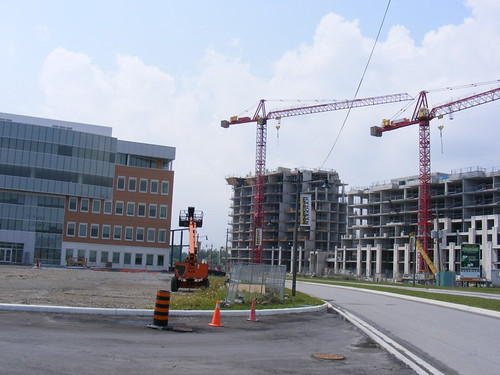 Nearly complete office building and new condos are the first phase of Downtown Markham
Nearly complete office building and new condos are the first phase of Downtown Markham
The master plan (for which it will take up to 15 years to complete, they are currently in year 2) is, at a glance, impressive, and will include a mix of residential condos and townhouses, offices (towards Highway 407) (you can read the discussion on Urban Toronto for more commentary), and an east-west pedestrian/transit mall. A commercial core, with renderings showing a covered pedestrian retail strip, is proposed for the centre. It is certainly different from previous corporate suburbs in form, such as Don Mills or Bramalea (both one-developer communities with some mixes of land use and a central commercial core), but has the same spirit that comes with any master-planned community. It will take years to find out if this rather bold experiment can work, and if it will be as urban and dynamic as civic officials hope and the developers promise. But reports on Urban Toronto have claimed that sales are brisk for the units now available for sale.
Meanwhile, Markham has two real downtowns, Unionville and “old” Markham, both small villages that were consumed by Toronto’s suburban growth. It is interesting that none of all the highrise development will be located here. All the development is planned for the immediate Highway 7 corridor, including Downtown Markham, between Kennedy and Woodbine.
Here’s some more photos I took exploring what is supposed to become an urban core. I would like to see it work, but I just have too much skepticism that it can be pulled off without the more organic development cycle of a true downtown.
 Other development in the Markham Centre area in the distance.
Other development in the Markham Centre area in the distance.
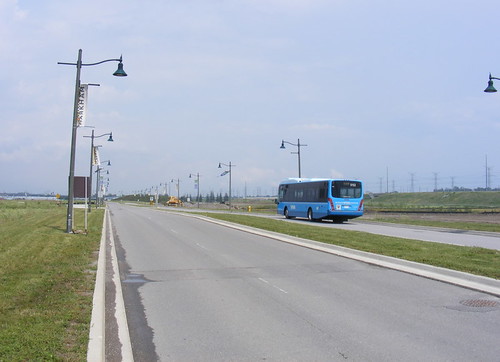 A Viva bus goes east on a lonely Enterprise Drive, towards the future intersection with Birchmount Road.
A Viva bus goes east on a lonely Enterprise Drive, towards the future intersection with Birchmount Road.
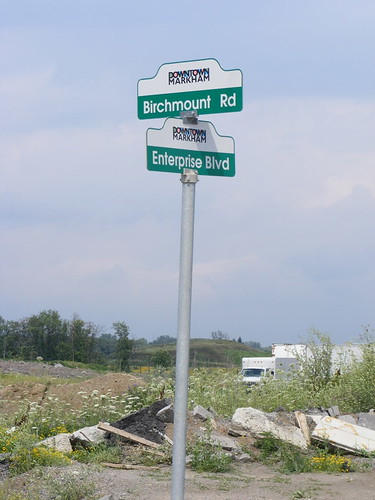
At least unlike Mississauga Centre, there will be a GO station, Unionville, adjacent. That, plus the Viva bus routes, will help with the attempt to make this a walkable area. The suddenly appearing bike lane appears to be slightly optimistic, and the sidewalk appears and disappears here.
I just thought this photo was kind of neat, taken as I was waiting for a bus to Markham Road.
Next, I explore one of Markham’s two original downtowns, and a quirky attempt to preserve some of Markham’s old Victorian houses.

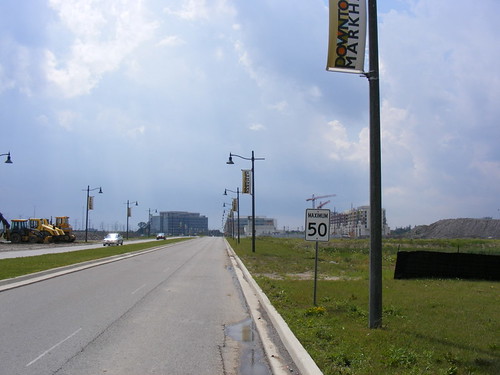
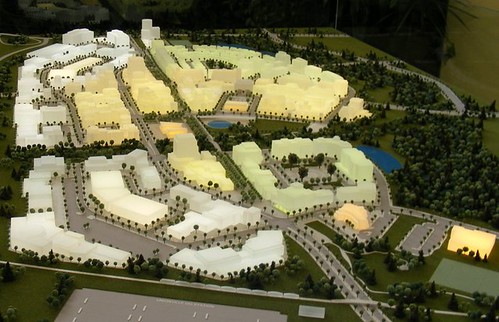
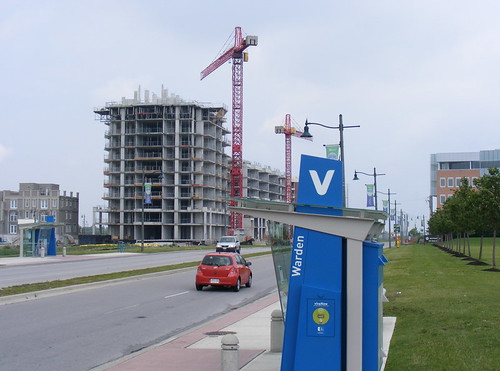
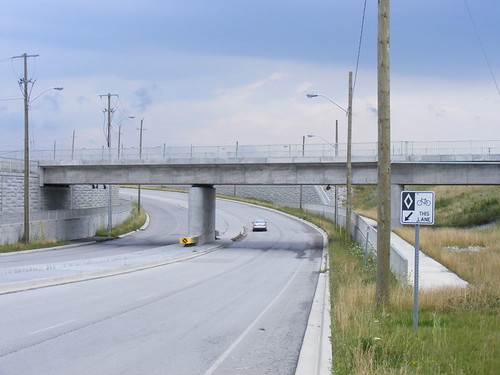
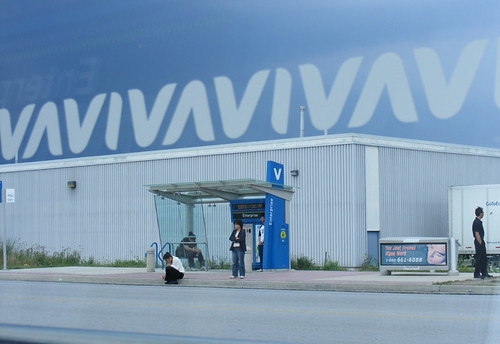

23 comments
Markham should be commended for this effort. Imagine how much better off we’d be if this was the kind of development the suburbs were building for the past 40 years.
Disgusting.
My family is from Caledon, and I cringe each time I come home and do the drive north from Toronto. Each time, tentacles of American influence creep closer to wilderness; grasslands, forest, rivers.
Where does our food grow if we keep builing over it?
Who cleans our water if the land doesn’t?
When do we stop “if they build it, they will come”.
Just disgusting.
Matthew: This is hardly like paving over fields of wheat blowing in the breeze, or untouched forest. The area is, quite simply, a wasteland between the 407 and Highway 7. Look at it on Google Maps: http://tinyurl.com/68396q
What’s more, this is intensification, and good intensification, from the looks of things. Regardless of how the neighborhood turns out, the bottom line is there will be a densely populated urban area within a pre-existing developed area that’s transit accessible and not dumped right on the edge of the city. Of all the developments in the GTA to call disgusting, this is not the one.
To be a “downtown” there must be rapid transit, commuter rail station, sidewalks, multi-use high-rise buildings, pay parking, shopping (not just chain stores or franchises), entertainment, hospitals, schools and universities, a city hall, public square, and most important, people.
Yeah, I’m thinking Matthew has no idea where this development even is, and why it’s happening.
Frankly, I’m not sure what to think about all this. On the one hand, it’s great that they’re finally putting this land to some use, and they’re taking transit, pedestrian, and bike traffic into heavy consideration in the process. That itself is a huge milestone for suburban development.
On the other hand, I’m not entirely sure what kind of people will inhabit this “downtown” area. Are we going to see the same people who currently live in Markham take up a spot here? Or are we going to see more downtown Toronto dwellers moving up north?
I’m slightly worried that this will attract too many unwanted persons, of the criminal type.
But regardless, I’m really glad York Region is taking transit so seriously over the past few years. We have one of the best bus services one could hope for in a suburban region such as ours. Now to only make it better…
It’s important to note that higher-order transit exists BEFORE the development is happening, rather than coming to serve a population already exists. That way, when residents finally move in, they will be used to having the VIVA and GO right at their disposal, and at no point will they need a car. Yes, ridership may be low at first, but it’s very important to form a habit. A good example of doing it the wrong way would be Cornell Meadows, just to the east. Which has yet to have VIVA service, but is considered “new urbanist”, but certainly not transit-oriented.
Also, it’s nice to see those bike lanes.
It’s easy to look at what the area looks like now and say yes, it’s a write-off. Even easier to criticize someone for claiming it used to be worth keeping.
When they let the Italian company who owns the 407 go ahead and put it in – another link of the NAFTA Superhighway – they opened the door for all of this development to take place in the name of economic growth. Without this highway, it’s tough to imagine this area ever ‘needing’ to be touched.
As I mentioned, my family has been in this are for hundreds of years (Raeburns Corners settled by my ancestors is now Caledon Village) and I have seen in my lifetime the destruction of grasslands, forests, watersheds, etc. so we can have this growth, not to mention what my grandfather has see first hand in his fight to save the Credit River Valley.
Look at the American model that is now crumbling. It’s a make-work project that is short sighted at best. But people will pay for it in the end, and like what has happened in the USA, these places will soon be abandoned when no one can afford to occupy them.
“If you know your history, then you you will know where you’re coming from.”
Raffi, please tell me you’re kidding about what “kind of people” will live in Markham Centre? This type of thinking is 40 years out of date. The answer: all kinds, and that’s good. Variety is what makes urban centres lively, interesting, and vital. To be successful a downtown has to have workers, residents, shoppers, and tourists using it at all times of day. If that is to happen, you can’t edit out the “kind” of people who don’t suit your tastes.
While Markham Centre obviously still has wrinkles to work out, this type of development I think takes some patience. Remember, when traditional downtowns were growing, the automobile was not ubiquitous, so it was natural for cities to grow as they did. Downtown Markham is an attempt to do something that goes counter to the unfortunate development approach that has become standard, so the early stages won’t always be pretty.
But compare this to Vaughan Corporate Centre, where the most significant development to this point has been a WalMart.
Matthew, the quote you include is ironic given your limited grasp of recent history. The government of Ontario started planning the 407 in the 60s (long before Free Trade) and was its owner throughout its construction. It was only after it was built that they sold it to a Spanish-Australian-Canadian consortium (no Italian company involved).
Not everyone in the Toronto area today would fit within the old “Metro Toronto” boundaries. The area has plenty of true suburban sprawl to criticize on principle, including sustainability. But this development — walkable, mixed-use, well-connected to transit — looks like part of the solution, not part of the problem.
Asher, I agree — seems like the hardest part might be getting a full range of incomes, especially if everything will be built fairly quickly and there aren’t any rental apartment buildings planned.
Denis wrote, “It’s important to note that higher-order transit exists BEFORE the development is happening, rather than coming to serve a population already exists.”
That is a very important point. While it is nice to think that rapid transit improvements will “get people out of their cars”, it really does not do this to any great extent (aside from getting people out of their car a couple of kilometres early because they were driving to a station already).
Perhaps a number of the new residents may be moving from downtown Toronto, where they are used to using transit to a greater degree than the typical 905 resident. If they arrive to an area with a decent level of service, they continue to live their lives the same way. If they arrive and the transit service is lousy, they switch to cars and may never switch back, regardless of gas prices.
On another note, kudos to Matt L for pointing out several items of misinformation in Matthew’s post, including that the 407 was planned in the 60’s, long before NAFTA was a gleam in a politician’s eye. In fact, some of the land for it was acquired as early as 1965 – before the 401 was fully end-to-end completed in 1968!
GO double-deck bus?
Really??
At this point, you could almost say that Enterprise Dr. is the GTA’s only busway!
Matt: Good point about the lack of income groups that will be represented here. As an all-condo and townhouse development, with some offices and shops, there will not be the mix of incomes that is present in organic downtowns, from downtown Toronto to downtown Brampton to even North York Centre or even Mississauga Centre (where there are several large rental apartment slabs and pylons from before the area was designated as Mississauga’s civic focal point.
Christopher: Yep. Though they will only be used on the 407 service for now (right now only doing the York U-Square One-Oakville/Streetsville routes), so they won’t be found in interesting urban areas, unlike London or Victoria.
This was a bit of a weird article — it dubs initiatives like these “Instant Downtowns”, then criticizes them for not being instant.
First it will get built. Then it will get lived in. Then change will happen. And eventually it will become a core. The thing to concentrate on is whether it’s a good infrastructure, not on whether it’s instantly a downtown — those just can’t exist, sorry.
Matt L:
Thank you for clarifying my point, but you’ve only made it stronger.
“The government of Ontario started planning the 407 in the 60s”
As a ring road like most cities did at the time. Look at the US model for suburbanization. Not possible without the ring road (and cheap gas of course)
“(long before Free Trade)”
I doubt that…
“and was its owner throughout its construction.”
Not all of it, as you can see by the current state of the 407, and what has been constructed since the sale of this road.
“It was only after it was built”
It is certainly not done, and wasn’t done at the time of the sale.
“that they sold it to a Spanish-Australian-Canadian consortium (no Italian company involved).”
DOESN’T THIS RING ANY BELLS FOR ANYONE?? Why would this road be sold to MULTINATIONAL CONGLOMERATE if it is JUST A RING ROAD??
People come on. We seem to be complacent in what is happening to our suburban areas. All the comments on this particular topic seem to say “yay! Toronto is doing suburbanization properly!”
not…uh why are we doing this at all?
Maybe the quote should be…if you know where you’re coming from, then you MUST know your history.
Italian, Spanish, Australian, whatever. It’s wrong and it’s happening. Wake up and smell the Tim Hortons on every corner.
First of all, I love the photos. They really show the problems associated with creating instant downtowns. In Mississauga’s case, the City Centre was doing very well for a long while, booming with office development until the early 1990s when it stagnated. It became a better investment to build condos in the early 2000s and without rapid transit there it has become entirely auto-oriented. Markham has been quite clever with its methods to attract business and higher density development with a city owned district energy company and, as you say, has the advantage of transit connections. It will be interesting to see how it all plays out over the next decade.
Mississauga released the Office Strategy Study which focuses a fair bit on the City Centre. It is on their website at http://www5.mississauga.ca/agendas/planning/2008/06_09_08/Item01OfficeStrategyStudy.pdf if anyone is interested.
Matthew:
Once again, downtown Markham is THE least of your worries! Whether freeways are owned by the government or a corporation is irrelevant.
The province of Ontario has currently committed to extending Highway 404 (what created suburban Markham in the first place when it was extended north of Steeles!) all the way to Keswick and beyond. Considering that Keswick is already rapidly being filled by subdivisions without even being connected to a 400-series highway OR the big pipe (York-Durham sewage line), it scares me how far away the next generation of leap frog developments will be once Keswick becomes the new Newmarket/Aurora.
Now tell me that intensifying empty land in Markham (relatively close to Toronto when you consider that people commute from BARRIE to downtown) that is well-served by transit and a plethora of corporate head offices is a bad thing. Markham is hands-down the most progressive suburban municipality in Canada and if anyone can make it work, they can. There are tons of high-paying jobs in Markham – unlike most suburbs, it’s actually possible to afford a house here on a salary paid within the same place.
Of course further suburbanization is foolish in the era of peak oil. But it’s well-entrenched in GTA culture (more people live in 905 than 416, including many middle-aged adults who grew up in the first suburbs and moved somewhere similar when they bought their own home) and is supported by massive government subsidies to suburban infrastructure. Pretending that the Markham development is anything like what’s been happening in York Region since the 70s is dishonest. Change will not happen overnight. I think Markham is striking a great compromise between pragmatism and idealism.
As to who will live here, I envision it as similar to North York City Centre. Many of Markham’s immigrant communities are probably less resistant to high-rise living than those who’ve been indoctrinated into thinking detached houses are the only acceptable way of living for the middle classes.
Great article, comments and view points.
I would just like to highlight the role immigration has on development. It should be pointed out that in 2006 68.9% of new immigrants settled in Toronto, Montréal and Vancouver (aka the big three).
This explains why there is no rental units being proposed for suburban (instant) downtowns. In the GTA we have immigrants landing and living in Toronto, they settle here because of the large immigration population (50%+ of residents are foreign born), which makes them feel more at home. Toronto has a large concentration of social services geared towards immigrants. After they settle in (learn the language and get a decent job), most are forced to leave Toronto, unless they want to rent for the rest of their lives or have enough money to afford a home in the City. As experienced immigrants leave Toronto, they make room for new immigrants to come in, and the cycle continues anew.
This brings me to my last and final point, the suburbs are growing not because of the ‘if you build it they will come’ phenomenon. Instead it would be more accurate to say ‘build it, they are coming’.
My input will end with the statement that immigration is whats keeping our economy afloat. The only thing we have to do is find an adequate way of attaining economic, social and environmental sustainability. Its a complex problem to say the least.
Let’s get real on the question of Immigration.
A recent conference of the Fraser Institute was held in Montreal. In that conference, according to the Ottawa Citizen July 16 2008, a group of Canadian, American French and British experts “skewered every orthodoxy associated with high rates of immigration…no, immigration won’t address the revenue vacuum created by an aging population, .. unless it reaches stratospheric levels” and so on.
Immigration is NOT what keeps our economy afloat.
Go to the Fraser Institute website and read the conference report with references.
(delivered in a very sarcastic tone) Oh yes, the Fraser institute is a great source for a perspective on immigrants!
Its full of bigots. I suspect any research they do is skewed to make us fear immigrants rather than embrace their skills and culture.
Lief, I “suspect” that you are a knee-jerk liberal who shoots from the hip, and is not interested in any intelligent debate on these issues.
Hi Norm
Keep making assumptions, why don’t you. This is nothing personal against “Immigrant” or you, so I don’t know why you want to call me names. If you want an intelligent debate, don’t start it by making repeated comments that contradict your point.
Anyway, Its a highly accepted notion that the Fraser Institute is purely ideologically driven, and that ideology has been shown to be extremely flawed in practice both here in Ontario and south of the border.
Secondly, the “faces” of the Fraser have well documented political pasts that clearly indicate their loathing of immigrants (Ipperwash, Reform Party anti-immigrant policies, etc)
If I want studies that can give me a good look at immigration and their effect on our economy I will look to the Big Banks and other non-politically affiliated organizations.
Little late to the party (you never know what kinds of blogs you’ll find with Google and a little spare time =D), but I would like to note that the 401/427 were the original suburban ring roads for Toronto. Then it was the 401/403, and now it is the 401/404/407 (though former Hwy 48 – Markham Rd is more geographically accurate, for simplicity’s sake we’ll keep it focused on expressways).
Actually, one could argue that it is 401/404/407/403/Lincoln-Red Hill Parkways are the true suburban ring roads for the Toronto (and Hamilton) urban area.
Point I’m trying to make is that suburbanization is not some new phenomenon that people like Matthew try to make it out to be. The ‘416 vs 905’ arguments dumb down the discussion, especially since from a political perspective, most of the 416 was suburban until only 10 years ago. Suburbanization is how cities grow. 125 years ago the communities of Leaside, Spadina Heights (now known as Forest Hill), Eglinton, and Davisville were nothing more than bedroom communities outside Toronto’s urban area – which ended at Bloor St at the time. Over time rural communities become suburban, and suburban becomes urban. The problem is that since the 70s, suburban growth has had poor land use and has sprawled grossly. If we had a more focused view of urban growth, areas like Oakville, Vaughan (assuming the Spadina Expressway was never built and transit to the area remained poor), Aurora, and Whitby would be rural/bedroom communities, not part of the Toronto urban area itself.
Fortunately, the Green Belt is curbing this out of control growth, and is forcing developers to use land more responsibly. And is the reason why we are seeing developments like “Downtown” Markham (the real downtown will always be at 7 and 48).